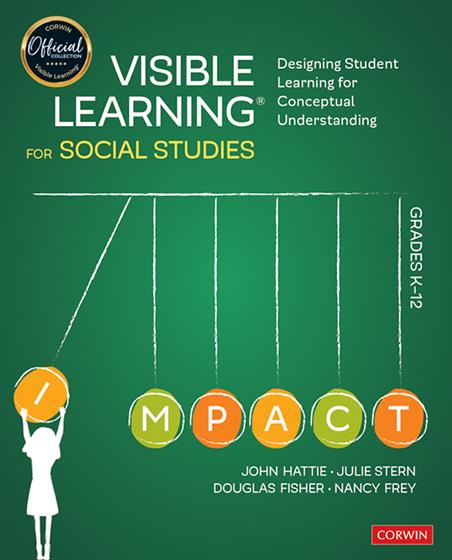
Hands-on, Practical Guidance for Educators
From math,
literacy, equity, multilingual learners, and SEL, to assessment, school counseling,
and education leadership, our books are research-based and authored by experts
on topics most relevant to what educators are facing today.
Visible Learning for Social Studies, Grades K-12
Visible Learning encapsulates a scaffolded approach in which students move from surface-level learning to deep learning, concluding with the transfer of concepts, skills, and strategies.
- Grade Level: K-12
- ISBN: 9781544380827
- Published By: Corwin
- Series: Corwin Teaching Essentials
- Year: 2020
- Page Count: 192
- Publication date: April 24, 2020
Review Copies
Review copies may be requested by individuals planning to purchase 10 or more copies for a team or considering a book for adoption in a higher ed course. To request a review copy, contact sales@corwin.com.
Description
Read this review from the National Social Studies Supervisors Association, Spring 2021:
https://us.corwin.com/sites/default/files/vlss_from_nsssa_the_leader_spring_2021.03_002_0.pdf
Help students move from surface-level learning to the transfer of understanding.
How do social studies teachers maximize instruction to ensure students are prepared for an informed civic life? VISIBLE LEARNING® for Social Studies, Grades K-12 shows how the field is more than simply memorizing dates and facts—it encapsulates the skillful ability to conduct investigations, analyze sources, place events in historical context, and synthesize divergent points of view.
The Visible Learning framework demonstrates that learning is not an event, but rather a process in which students move from surface-level learning to deep learning, and then onto the transfer of concepts, skills, and strategies. Encouraging learners to explore different facets of society, history, geography, and more, best practices for applying visible learning to social studies curriculum are presented through:
· A scaffolded approach, including surface-level learning, deep learning, and transfer of learning
· Examples of strategies, lessons, and activities best suited for each level of learning
· Planning tools, rubrics, and templates to guide instruction
Teachers must understand the impact they have on students and select approaches to maximize that impact. This book will guide you through the process of identifying the right strategy for the right time to successfully move students through surface, deep, and transfer learning.
Key features
- Strategies supported by the Visible Learning research
- Examples across disciplines within social studies
- Planning tools
- Rubrics
- Templates
Author(s)

John Hattie

Julie Harris Stern
Julie Stern is the best-selling author of Tools for Teaching Conceptual Understanding, Elementary and Secondary, Visible Learning for Social Studies, and Learning That Transfers. She is the thought leader behind the global workshop series Making Sense of Learning Transfer, and is a certified trainer in Visible Learning Plus. Her passion is synthesizing the best of education research into practical tools that support educators in breaking free of the industrial model of schooling and moving toward teaching and learning that promotes sustainability, equity, and well-being. She is a James Madison Constitutional Fellow and taught social studies for many years in Washington, DC and her native Louisiana. Julie moves internationally every few years with her husband, a US diplomat, and her two young sons. Her website is www.edtosavetheworld.com.

Douglas Fisher
Douglas Fisher is professor and chair of educational leadership at San Diego State University and a leader at Health Sciences High and Middle College. Previously, Doug was an early intervention teacher and elementary school educator. He is a credentialed teacher and leader in California. In 2022, he was inducted into the Reading Hall of Fame by the Literacy Research Association. He has published widely on literacy, quality instruction, and assessment, as well as books such as Welcome to Teaching, PLC+, Teaching Students to Drive their Learning, and Student Assessment: Better Evidence, Better Decisions, Better Learning.

Nancy Frey
Nancy Frey is professor of educational leadership at San Diego State University and a leader at Health Sciences High and Middle College. Previously, Nancy was a teacher, academic coach, and central office resource coordinator in Florida. She is a credentialed special educator, reading specialist, and administrator in California. She is a member of the International Literacy Association’s Literacy Research Panel. She has published widely on literacy, quality instruction, and assessment, as well as books such as The Artificial Intelligences Playbook, How Scaffolding Works, How Teams Work, and The Vocabulary Playbook.
Table of Contents
List of Figures
List of Videos
About the Authors
Acknowledgments
Chapter 1. Laying the Groundwork for VISIBLE LEARNING® for Social Studies
The Evidence Base
Noticing What Works
Learning From What Works
General Learning Practices
Conclusion
Chapter 2. Surface Learning in Social Studies
Why Surface Learning Is Essential
Surface Acquisition and Consolidation
Acquisition of Social Studies Learning Made Visible
Consolidation of Social Studies Learning Made Visible
Conclusion
Chapter 3. Deep Learning in Social Studies
Moving From Surface to Deep
Deep Acquisition and Deep Consolidation
Deep Acquisition of Social Studies Learning Made Visible
Deep Consolidation of Social Studies Learning Made Visible
Conclusion
Chapter 4. Teaching for Transfer in Social Studies
Moving From Deep Learning to Transfer
Types of Transfer: Near and Far
The Paths of Transfer: Low-Road Hugging and High-Road Bridging
Setting the Conditions for Transfer of Learning
Teaching Students to Organize Conceptual Knowledge
Teaching Students to Transform Conceptual Knowledge
Conclusion
Chapter 5. Determining Impact, Responding, and Knowing What Does Not Work
Determining Impact
Responding When There Is Insufficient Impact
Learning From What Doesn’t Work
Conclusion
References
Index
Reviews
As I read this book I became increasingly aware of my own self-talk saying: 'yes, of course, that’s absolutely right, that’s what we must do, now I get it.' The authors reassert a vital humanist approach to what, how and why students learn about their societies, history, culture and the wider world around them. It reminds us that we have a duty to prepare young minds for complex global challenges with a deep, critical and nuanced understanding.
Neville KirtonAs I read this book I became increasingly aware of my own self-talk saying: 'yes, of course, that’s absolutely right, that’s what we must do, now I get it.' The authors reassert a vital humanist approach to what, how and why students learn about their societies, history, culture and the wider world around them. It reminds us that we have a duty to prepare young minds for complex global challenges with a deep, critical and nuanced understanding.
Deputy Head of Secondary (9-11), Colegio Anglo Colombiano, International Baccalaureate
This book is a wonderful addition to any busy teacher or curriculum writer’s library. Meant for K-12, it is easy to read and implementable at any point in the year. The strategies provided teach students to utilize their background knowledge but dare to think critically in unfamiliar situations.
Heather Giustiniani,This book is a wonderful addition to any busy teacher or curriculum writer’s library. Meant for K-12, it is easy to read and implementable at any point in the year. The strategies provided teach students to utilize their background knowledge but dare to think critically in unfamiliar situations.
International Baccalaureate Primary Years Programme Coordinator
Visible Learning for Social Studies will inspire teachers, guide curriculum coordinators and instructional coaches, and will help educators bring transfer and thinking back into the humanities classroom. This book will help humanities teaches rediscover the value of their subject and will revitalize their approach to designing learning.
J. Rafael ÁngelVisible Learning for Social Studies will inspire teachers, guide curriculum coordinators and instructional coaches, and will help educators bring transfer and thinking back into the humanities classroom. This book will help humanities teaches rediscover the value of their subject and will revitalize their approach to designing learning.
Concept-Based curriculum & Instruction Trainer and Consultant; MYP Coordinator, GIS Dubai
This is that unicorn of education books; it combines compelling classroom stories with accessible, relevant information about the research undergirding the change ideas. It is rich with resources and tools that teachers can use to make immediate changes in their units, but more than that, it will inspire teachers to pursue their own change ideas and research as they work to create just and equitable classroom communities.
Angela WilcoxThis is that unicorn of education books; it combines compelling classroom stories with accessible, relevant information about the research undergirding the change ideas. It is rich with resources and tools that teachers can use to make immediate changes in their units, but more than that, it will inspire teachers to pursue their own change ideas and research as they work to create just and equitable classroom communities.
IB MYP Coordinator, Hopkins Public Schools, Minnesota
While most books on educational pedagogy focus on areas outside of social studies, Visible Learning for Social Studies takes John Hattie’s critical work and makes it accessible for social studies teachers. The authors provide a clear and practical guide to implementing the most effective, evidence-based teaching strategies that will engage your social studies students. This book is a must-read for social studies teachers of all grade levels.
Kevin LopuckWhile most books on educational pedagogy focus on areas outside of social studies, Visible Learning for Social Studies takes John Hattie’s critical work and makes it accessible for social studies teachers. The authors provide a clear and practical guide to implementing the most effective, evidence-based teaching strategies that will engage your social studies students. This book is a must-read for social studies teachers of all grade levels.
Mantinoba Social Science Teachers’ Association (MSSTA), Department Head – Social Studies, Lord Selkirk Regional Comprehensive Secondary School, Selkirk, MB, Canada
Having a resource like this – with so many applicable strategies and examples – will assert a conversation around social studies education in my division. This resource aligns with our division’s goal of more rigorous and relevant assessment, paired with appropriate feedback.
Vince BustamanteHaving a resource like this – with so many applicable strategies and examples – will assert a conversation around social studies education in my division. This resource aligns with our division’s goal of more rigorous and relevant assessment, paired with appropriate feedback.
Social Studies Curriculum Consultant
Visible Learning for Social Studies is an instructional treasure trove for teachers of social studies. The authors offer practical, usable and specific instructional strategies that work best at the surface, deep and transfer phases of learning with examples from kindergarten to grade 12. In today’s world of mass media, social studies lessons must engage students in learning at deeper levels and help them develop a fluency in critical literacy skills. With that purpose, this book is a must-have, must-use text for all social studies teachers.
Cathy J. LassiterVisible Learning for Social Studies is an instructional treasure trove for teachers of social studies. The authors offer practical, usable and specific instructional strategies that work best at the surface, deep and transfer phases of learning with examples from kindergarten to grade 12. In today’s world of mass media, social studies lessons must engage students in learning at deeper levels and help them develop a fluency in critical literacy skills. With that purpose, this book is a must-have, must-use text for all social studies teachers.
As a nationwide movement grows to provide greater support for K-12 social studies education, books like this provide first-hand, data-driven recommendations for how educators can enhance student learning in this space. If you are part of the effort to improve social studies education in this country, you should read this book.
Julie SilverbrookAs a nationwide movement grows to provide greater support for K-12 social studies education, books like this provide first-hand, data-driven recommendations for how educators can enhance student learning in this space. If you are part of the effort to improve social studies education in this country, you should read this book.
Visible Learning for Social Studies is an essential addition to the learning library of all social studies educators who are looking to connect research-based best practices with the different ways we engage our students in learning. Best of all, the research is clearly connected to classroom-ready examples that give K-12 teachers the support they need to implement the ideas from the book in order to best support moving their student learning forward. I would highly recommend this book to social studies educators at all grade levels as it cleanly synthesizes decades of research into usable examples based on the different learning levels (surface, deep, and transfer), with support around understanding the importance of the research and the impact in your own classroom.
Joe SchmidtVisible Learning for Social Studies is an essential addition to the learning library of all social studies educators who are looking to connect research-based best practices with the different ways we engage our students in learning. Best of all, the research is clearly connected to classroom-ready examples that give K-12 teachers the support they need to implement the ideas from the book in order to best support moving their student learning forward. I would highly recommend this book to social studies educators at all grade levels as it cleanly synthesizes decades of research into usable examples based on the different learning levels (surface, deep, and transfer), with support around understanding the importance of the research and the impact in your own classroom.
Review Copies
Review copies may be requested by individuals planning to purchase 10 or more copies for a team or considering a book for adoption in a higher ed course. To request a review copy, contact sales@corwin.com.
Related Professional Learning
Related WebinarsRelated Resources
- Access to companion resources is available with the purchase of this book.
- Examples of Surface, Deep, and Transfer Strategies in Geography [Lessons and Strategies]
- Feedback Strategies to Use in the Classroom [Lessons and Strategies]
- Laying the Groundwork for Visible Learning [Lessons and Strategies]

